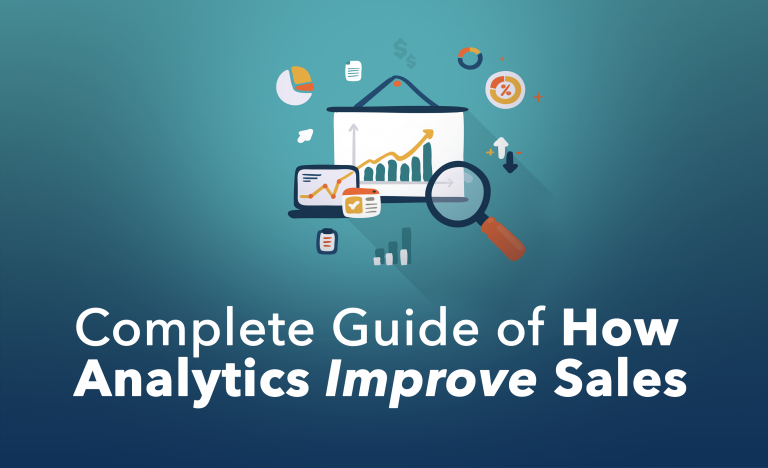Understanding how sales metrics work, as well as how analytics improve sales, is a crucial step to having a successful business. Many entrepreneurs and businesses do not understand how essential sales metrics are nor how to track them. Today you will take a crash course on sales metrics and KPIs (Key Performance Indicators) and learn how analytics improve sales.
What Are Sales Metrics? Sales metrics are data and information used to judge a company’s overall performance. Most people use sales metrics to look at the overall performance of a company, a team, or a division in a company and individual performance.
These data points are gathered to create an overall view of what is happening. Some standard sales metrics from a marketing standpoint include:
- Business Growth
- Overall Sales Growth
- Sales Growth in Specific Areas (markets, product lines, specific types of customers)
- Percentage of Leads that Become Profitable
- Outstanding debt, delinquent customers
- Marketing conversion numbers
As you can see, there is a lot that you can do with sales metrics. This is why it is essential to understand the importance of the data, how to collect and track it and what you can do with it. Raw data can be used to see what is going right and not and then to map a plan going forward.
Understanding Common Sales Metrics

Now that you know what sale metrics are, you should make a list of different common sales metrics you may choose to use in your own business. There are so many different sales metrics available to use. Remember, analytics improve sales, so you must find the right metrics for your business. Make a list of all the different sales metrics that could be useful, and start with a few that seem best suited to your needs.
Here are 5 sales metrics to consider:
Customer Acquisition Cost. Regardless of your business type, you will need to find a way to attract new customers. This will cost money. Businesses may spend money on leads, advertising, marketing, or paying the salary of a social media manager.
Sales Productivity. Another standard metric is sales productivity. This can be looked at by hours or money put in to get a sale, sign a client or make a specific dollar amount.
Revenue. Typically people look at revenue by quarter and by year. How much money or manpower did it take to make your total revenue last quarter. Once you do this, you can compare quarters to years to see where your sales are going.
Revenue Trends. You can compare the revenue in many different ways. For instance, do you make more of new or existing customers? Does the time of the month influence the revenue? What about the time of the year?
Average Revenue per Account. How much do you make per account? Once you understand an average, you can determine how many accounts you need to meet specific goals.
Why is it Important to Track These Common Metrics?

Although it is true that analytics improve sales, it is essential that you not only create common methods but learn how to track them as well. If you are not tracking metrics and performance, you will be unable to find where things are going well or poorly. Tracking metrics allows you to see the big picture and create best practices for your business.
If you need one solid reason for tracking metrics, remember that it will lead to success. You can analyze these findings if you run a marketing campaign, follow it, and see it perform poorly compared to other campaigns. This will teach you what works and what doesn’t, allow you to not repeat poor-performing campaigns, and ultimately, increase your bottom line.
Sales productivity can be measured and then you can determine what is the best way for your sales team to spend their time. For instance, statistics tell us that the best sales reps spend 65% of their time participating in direct sales whereas average to poor sales reps spend 65% of their time in non-selling activities. This information can help with training your reps and creating a better game plan.
Analytics is an essential part of any business. Currently, 60% of businesses worldwide use analytics and 78% of them feel that they are using the information effectively. This is a majority that you want to be a part of.
What are the Benefits of Monitoring Sales Metrics?
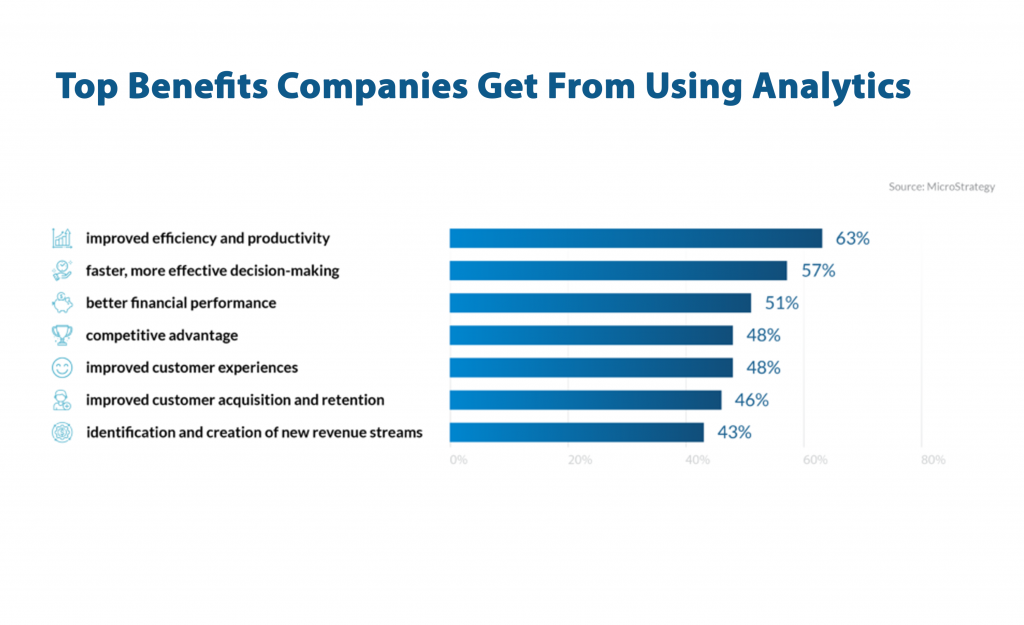
As an important business person, you know that time is money. Time is a limited resource, and even if you believe there is something to the idea that analytics improves sales, you need to know more. One of the most important questions you will have is, what is in it for me? After all, your time is limited. To add another task to your busy schedule, there must be some benefit for you and your company.
There are actually many different benefits to monitoring sales metrics. Here are a few of them:
- Understanding what marketing campaigns work for your company.
- Being able to project sales.
- Being able to prevent losses.
- Understanding what employees are performing the best.
- Employees who know metric tracking is happening work harder.
- Lowers overall stress as key individuals understand what sales are to be expected.
- Allows businesses to set achievable targets and goals.
As there are different sales metrics for every situation, using and tracking sales metrics can be really beneficial. For instance, you can dig much deeper than just tracking regular sales and revenue.
Once you are comfortable with sales metrics, you can track the number of deals or customers lost to competitors, the engagement rate on social media or your blog/website, click-through rates, unsubscribe rates, returning customers, and so much more!
What are the Disadvantages of Using Sales Metrics?

Over the past several years, everyone has been talking about sales metrics and analytics. Analytics improve sales when used correctly, but they are everywhere – including in all the major sports. When something becomes very popular, it is easy to believe there is only an upside. However, this is not true about anything. There are some drawbacks to using sales metrics.
Companies should use sale metrics to help create a plan for the future and maximize earnings. However, a significant drawback is that people and businesses can become so dependent on them that they can not see the forest beyond the trees. When using analytics and sales metrics properly, you are utilizing a tool to help you or your company succeed. Unfortunately, sometimes people focus so much on analytics that they neglect careful business planning and strategy.
Another problem is when companies are not tracking the right thing, or even worse, vanity metrics. The point of sales metrics is to use them to facilitate success. Some individuals will use them to create statistics that look good on outward appearances but do not help a company move forward. For instance, if you said you have a conference attended by 96% of invitees, that sounds great. However, when you include the actual data that this was a mandatory conference for employees, not prospective buyers, this stat is not looking good anymore.
Finally, using inappropriate metrics for your business can be a pitfall in sales metrics. What a small, medium, and large company needs to measure are different. Metrics are great, but you need to understand business and what is essential now and in the future to determine what to measure.
How To Identify Your KPIs and Key Metrics
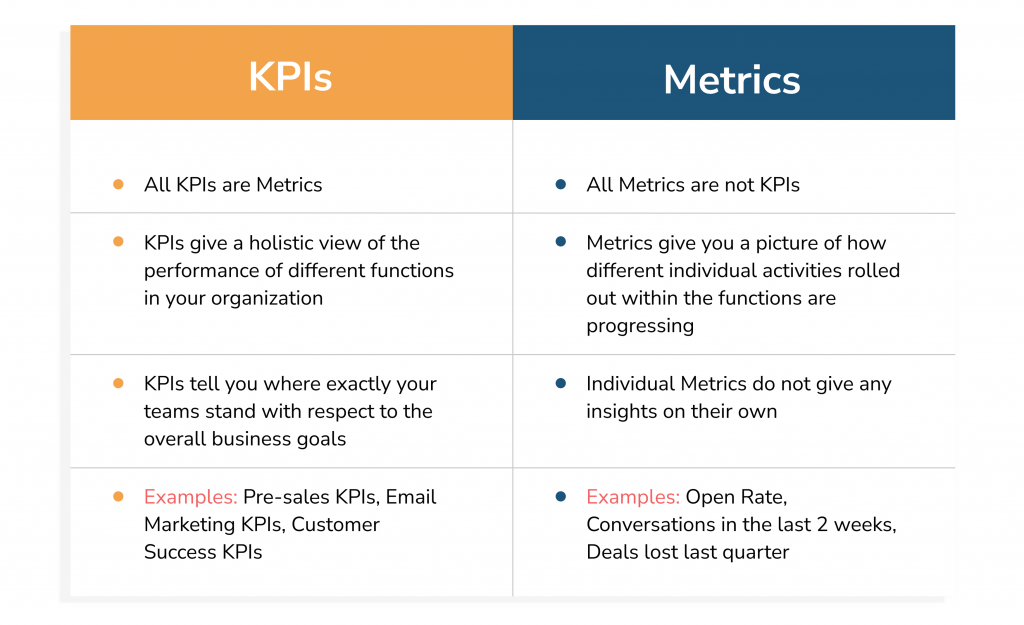
What is KPI? KPI stands for Key Performance Indicators. These are measurements of how a company progresses in the medium and long term. Running a business should never be only viewed in the short term, so it is crucial to understand how your business is doing now and how it is being set up for the future.
It is essential to choose key metrics that are highly related to sales goals and overall success. It is easy to fall into the trap of tracking too much information as sales metrics can be like a shiny new toy, and you want to use all the data you have in every way possible. However, choosing a few key metrics to track over the long term is much more advantageous. Analytics improves sales, but only when you are using them correctly.
You will want to think about the different metrics you can track and choose actionable ones aligned with your business goals and overall strategy.
There are many different key metrics to choose from. Initially, starting with ones directly related to sales and revenue would be best. Here are a few ideas to get you started:
- Profit
- Cost of Products Sold
- Sales By Timeframe
- Sales By Region
- Expenses vs. Budget
- Customer Lifetime Value
How to Measure Sales Performance Metrics and KPIs
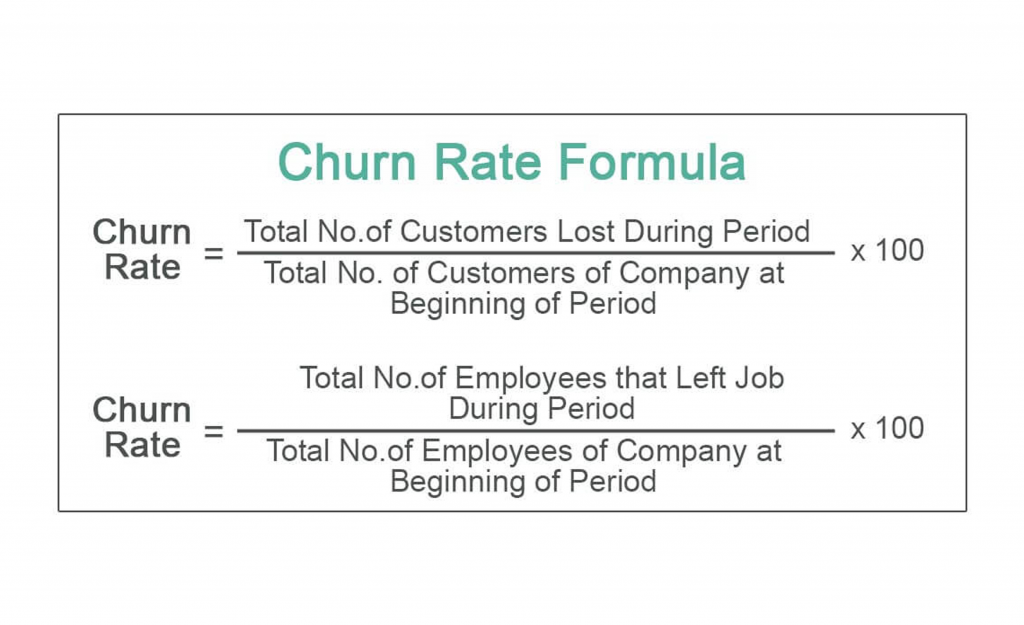
There are a few key terms that you need to understand to correctly measure sales performance methods and KPIs. Although analytics improve sales, to use analytics properly, you need to understand the methodology behind them. Here are 6 essential terms to keep in mind.
Sales Productivity Metrics – the rate at which sales reps meet their goals. The less time it takes, the higher the sales productivity.
Lead Response Time – The average time it takes a salesperson to follow up on a new lead. Leads can come in many forms, from referrals to newsletter subscribers.
Win Rate – how successful a team of sales reps is over a specified period. Using win rate can help companies understand their financial position better, predict future sales, and identify areas of weaknesses. Win rate can even be used as a statistic to share with shareholders or to secure funding.

Deal Size – consideration promised or paid concerning an acquisition. Although this could be cash, deal size can take multiple forms, including debt securities, stocks, or bonds.
Churn Rate – This is the rate at which a customer stops doing business with a company. It is just as important to understand how long a new customer will be working with a company (and contributing to the bottom line) as how many new customers come in over a specific period.
SQL – Sales Qualified Lead – SQL is more than a simple lead. This is someone who started as a lead but is now at the point where they are ready to become a customer. These are the best types of leads for sales reps.
What to Be Aware of When Using Sales Metrics
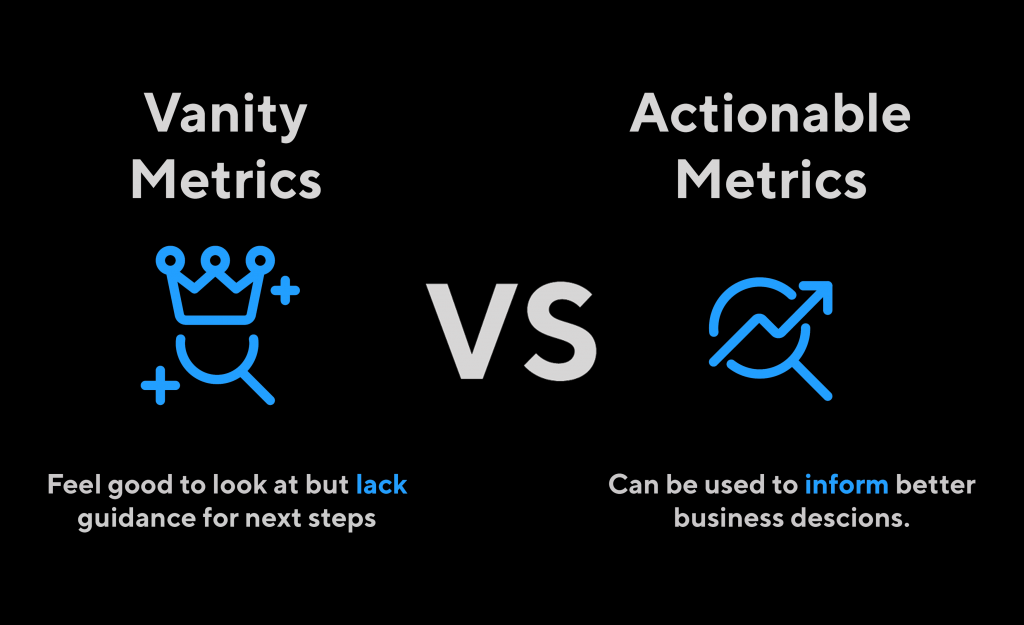
Running a successful business is hard work and takes a lot of attention to detail. Sales metrics can certainly help with this, along with analytics improving sales. Still, there are drawbacks in the form of vanity metrics and metric tracking mistakes.
Vanity metrics are one of the many pitfalls businesses fall into when using and tracking sale metrics. A vanity metric is created to showcase an individual’s or business’s talents. Still, it has little to no merit outside of this.
A common vanity metric is traffic, especially a large amount of traffic. This could be traffic to a website, a lead page, a sign-up form, or even a specific social media posting. At first glance, traffic is a wonderful metric. Everyone knows the more eyeballs you get to a brand, company, or product, the better. However, the problem is not promoting this metric; it is not questioning how that metric is tied to a specific business goal and how it is a useful stat. If you get 1 million likes on a social media post, that might be fabulous for branding, but how many of those 1 million people bought something or signed up for additional information?
Only report vanity metrics if they provide value to the business. Refer to the example above and compare it to the metric you think of. It is a vanity metric if it also does not help the overall business goal.
What Are Some of the Best Metrics For Improving Sales?
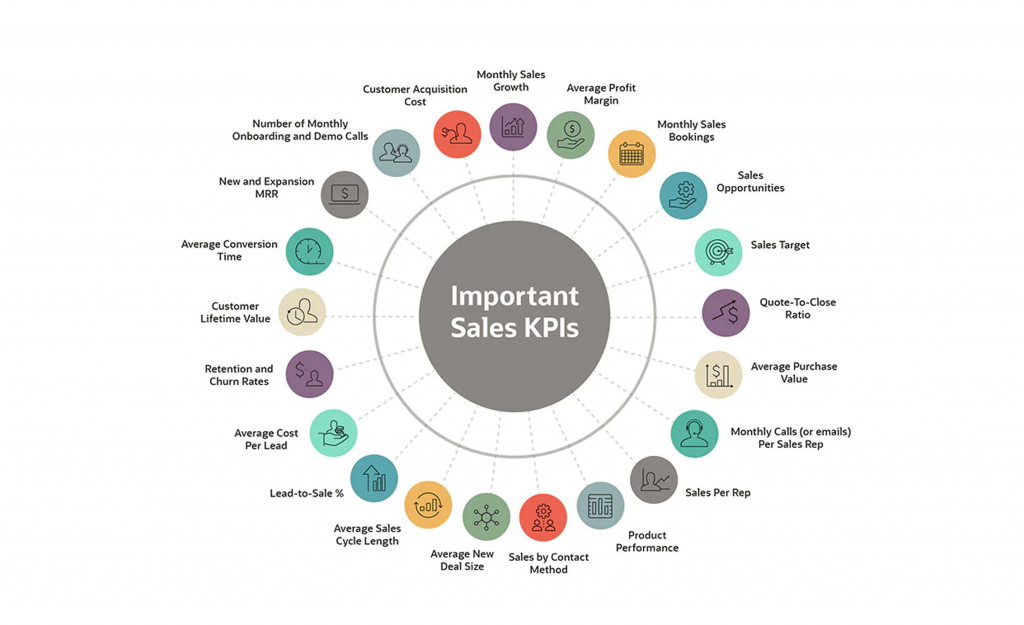
Now that you understand that analytics improve sales and sales metrics can be very useful in creating a successful business, it is time to decide which metrics to use. You will want to utilize the first type of metrics to help improve your sales. Here are our top 5 metrics that can be used to track your business and improve your sales.
Customer Lifetime Value – This metric will calculate a contract’s or customer’s lifetime value and determine an ROI – return on investment. It is essential because you can gauge how many customers or contracts you need to hit specific goals when you know this information.
Lead Velocity Rate is a critical metric to grow a business. A lead velocity rate (LVR) measures the growth in the number of quality leads a month. By tracking this number, you can determine if your lead magnets are doing their job or need improvement.
New Leads by Source – If your company gets leads from multiple sources, tracking how each source is doing is vital. Once you do this, you can tweak the poorer-performing sources to be more like the sources with the highest return.
Revenue by Lead Sources – You should also track how much revenue each source is producing monthly or quarterly. This is an important metric to know how vital each lead source is to a company or organization.
Lead Response Time – Finally, you will want to know how long a sales rep takes to follow up on a lead. This is important for multiple reasons. If it is taking too long, you may have a staffing issue. Also, but understanding the timeline, you can adjust business models to respond quickly to possible customers.
Final Thoughts on How Analytics Improve Sales
Sales metrics can be very beneficial to a company’s overall performance. If you are not already using metrics and analytics in your business, now is the time to start!
It has been proven time and time again that analytics improve sales when used properly. This is what you need to keep in mind when you start using metrics. Start with analytics and metrics designed to track and increase your sales. Many different sales and marketing-specific metrics are available; pick two or three and start with those.
Besides sales and marketing metrics, explore ones specific to your business type. For instance, if you participate in B2B sales, you should track metrics related to these activities.
Finally, please remember that using vanity metrics or over-relying on metrics and analytics could hurt your business and waste your time. Make sure you focus on why the metrics you use are useful, and always keep your business goals in mind.

